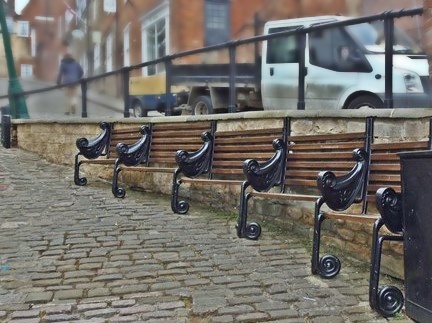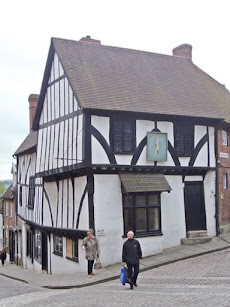Steep Hill links the lower city to the older, upper city. During the later Middle Ages Steep Hill was an enclave of the Jews. Lincoln had the second larget population of Jews in England after London.
Three of the oldest domestic buildings in Lincoln are on Steep Hill, two of them, Jews House and Jews Court are known to have belonged to Jews.
Jews House
Jews House is the last house on the Strait, but it is included here. It was built about 1170, like most houses of this age, it had a first floor hall with storage on the ground floor. The first floor window surrounds and decorative features are original although the windows are of more recent date
Originally, the ground floor would not have had windows, but ventilation holes would have been made into the walls. The chimneys on the roof are of more modern date: The house's chimney was built into the front wall over the main entrance, the arch would have had supports.
During the 12th and 13th century Jews throughout England suffered persecution: In Lincoln the Jews were blamed for the death of a Christian boy called Hugh. In 1290 Belasset of Wallingford, a Jew, lived in the house and was hanged in London for the offence of coin clipping.
The house then came into the possession of the Dean and Chapter of Lincoln Cathedral.
Most of the alterations to the House took place in the 18th and 19th centuries, the ground floor windows and additional doors were added during this time.
It is believed to be the oldest house still existing in England.
Jews Court
Jews Court stands at the southern, lower, end of Steep Hill. Built in the late 12th century and altered in the 18th, 19th and 20th centuries.
One of the upper rooms, it is thought, was used as a synagogue, but there are many factors which seem to disprove this and the general view is that the synagogue was at the rear of this building or the Jews House. At the 1290 inquest about the expulsion of the Jews it was stated that Jews Court was part of the communal Jewish property.
This area is famous for the story of "Little St Hugh", a Christian child said to have been murdered by Jews in 1255. The story was a fabrication and a plaque was placed in Lincoln Cathedral at the site of Hugh's burial
"By the remains of the shrine of "Little St. Hugh".
Trumped up stories of "ritual murders" of Christian boys by Jewish communities were common throughout Europe during the Middle Ages and even much later. These fictions cost many innocent Jews their lives. Lincoln had its own legend and the alleged victim was buried in the Cathedral in the year 1255.
Such stories do not redound to the credit of Christendom, and so we pray:
Lord, forgive what we have been, amend what we are, and direct what we shall be"
The Jews' Court was traditionally believed to be the site of the falsified martyrdom of Little Hugh and a well in a corner of the basement was alleged to be the place where the body was concealed. In 1911, Mr Dodgson who then owned Jews Court charged visitors 3d to see the well in the basement of Jews Court, claiming it was the very well Little Hugh had been found in. Plenty of people bought a ticket, but they were duped for not only was there no connection between Jews Court and Little Hugh, but the well had only been dug in 1910 by Harry Staples of Hereward Street, Lincoln, on Mr Dodgson's instructions.
In the late 1920s Lincoln was going through a major slum clearance, Jews Court narrowly escaped demolition, due to the efforts of Lincolnshire Architectural and Archaeological Society (LAAS) who were given the building by Lincoln Corporation on condition it was refurbished.
It is now the home of the Society for Lincolnshire History and Archaeology where an excellent new and secondhand bookshop can be found.
 |
| Well Lane |
Soon the steepest part of the hill is reached, a handrail is provided to help with the ascent.
The Mayor's Chair
A Lincoln mayor from a much earlier age provided seating against the wall at the end of this section for the weary walker. A good place to sit to view the lower city, although this view is partially blocked when the tree to the left is in leaf. A new Mayor‘s Chair was installed in 2010.
Harding House is a 16th century half-timbered building restored in the second-half of the 20th century. The home of "Aaron the Jew" was on this site in the 13th century . Aaron was a wealthy money-lender, lending money to kings as well as cathedrals and monasteries.
Today it is an art and craft gallery, run by an artists co-operative.
The Ground Floor Gallery features work by members of the co-operative, plus a wide variety of work by other artists and makers from around the country.
The Upper Gallery hosts an exhibition programme in all disciplines.
The Harlequin
the building known as "The Harlequin" is late 15th century, it was altered in the 19th century and restored in the 20th century. It has more recent refurbishment to preserve the building for many more years.The Harlequin inn opened in the 18th century and was renamed the Harlequin & Columbine* when it became the theatre inn; the theatre was at the far end of Wordsworth Street on Drury Lane. The Inn was closed by the city corporation in 1931 as unsuitable premises for a public house.

Norman House was once known as “Aaron the Jews House”, but Aaron may have lived in the Bail, above here, or in a house on the site of Harding House, a little further down Steep Hill.
It is a late 12th-century dressed stone and brick house situated on the east side of Steep Hill. It originally had shops on the ground floor and domestic rooms above. It has had a lot of rebuilding over the centuries, restored in 1878 and during the 20th century, but traces remain of the front chimney stack, ornamental string-course and doorway. The building is now home to a bag shop and a tea retailer.
The ground floor has two central entrance doorways, the left door is an 18th century insertion with an attached bow shop window and the right door is round headed with single shafts and crocket capitals under a truncated hood. To the far right is a casement shop window with a wooden pilaster surround and cornice and to the far left is a partially blocked small two light casement window.
Brown's Pie Shop

In 2011 Steep Hill won an award as "Britains Best Place", from the Academy of Urbanism.














